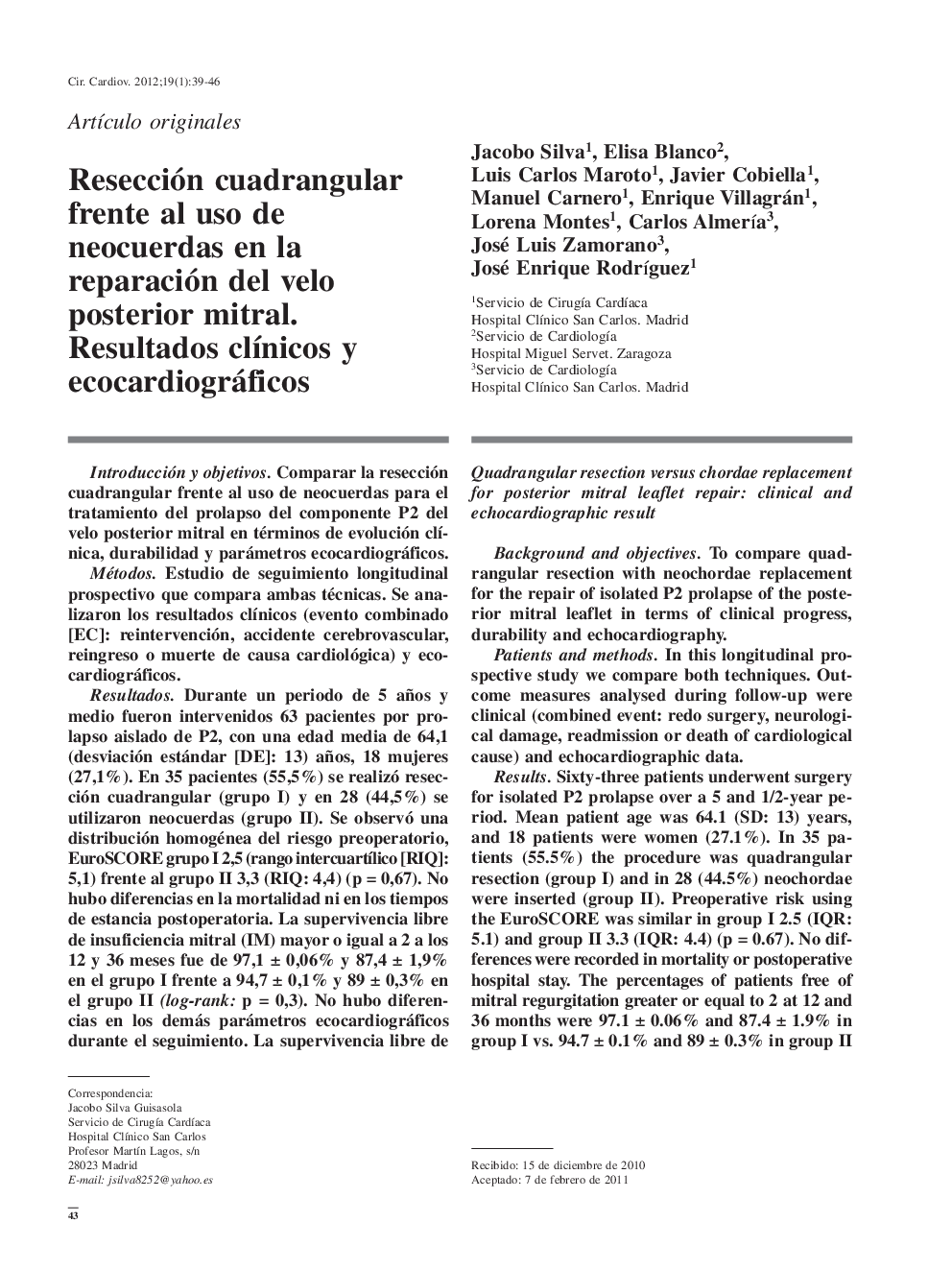| Article ID | Journal | Published Year | Pages | File Type |
|---|---|---|---|---|
| 2907637 | Cirugía Cardiovascular | 2012 | 8 Pages |
ResuménIntroducción y objetivos. Comparar la resección cuadrangular frente al uso de neocuerdas para el tratamiento del prolapso del componente P2 del velo posterior mitral en términos de evolución clínica, durabilidad y parámetros ecocardiográficos.Métodos. Estudio de seguimiento longitudinal prospectivo que compara ambas técnicas. se analizaron los resultados clínicos (evento combinado [EC]: reintervención, accidente cerebrovascular, reingreso o muerte de causa cardiológica) y ecocardiográficos.Resultados. Durante un periodo de 5 años y medio fueron intervenidos 63 pacientes por prolapso aislado de P2, con una edad media de 64,1 (desviación estándar [DE]: 13) años, 18 mujeres (27,1%). En 35 pacientes (55,5%) se realizó resección cuadrangular (grupo I) y en 28 (44,5%) se utilizaron neocuerdas (grupo II). Se observó una distribución homogénea del riesgo preoperatorio, EuroSCORE grupo I 2,5 (rango intercuartílico [RIQ]: 5,1) frente al grupo II 3,3 (RIQ: 4,4) (p = 0,67). No hubo diferencias en la mortalidad ni en los tiempos de estancia postoperatoria. La supervivencia libre de insuficiencia mitral (IM) mayor o igual a 2 a los 12 y 36 meses fue de 97,1 ± 0,06% y 87,4 ± 1,9% en el grupo i frente a 94,7 ± 0,1% y 89 ± 0,3% en el grupo ii (log-rank: p = 0,3). No hubo diferencias en los demás parámetros ecocardiográficos durante el seguimiento. La supervivencia libre de EC a los 12 y 36 meses fue similar en ambos grupos (grupo I: 97,1 ± 0,06% y 93,6 ± 0,08% vs grupo II: 94,7 ± 0,1% y 89 ± 0,15%; log-rank: p = 0,39)Conclusiones. En nuestra experiencia, la resección cuadrangular y el uso de neocuerdas mues-tran resultados similares a medio plazo en lo referente a durabilidad, evolución clínica y parámetros ecocardiográficos.
Background and objectives. To compare quadrangular resection with neochordae replacement for the repair of isolated P2 prolapse of the posterior mitral leaflet in terms of clinical progress, durability and echocardiography.Patients and methods. In this longitudinal prospective study we compare both techniques. Outcome measures analysed during follow-up were clinical (combined event: redo surgery, neurological damage, readmission or death of cardiological cause) and echocardiographic data.Results. Sixty-three patients underwent surgery for isolated P2 prolapse over a 5 and 1/2-year period. mean patient age was 64.1 (SD: 13) years, and 18 patients were women (27.1%). In 35 patients (55.5%) the procedure was quadrangular resection (group I) and in 28 (44.5%) neochordae were inserted (group II). Preoperative risk using the EuroSCORE was similar in group I 2.5 (IQR: 5.1) and group II 3.3 (IQR: 4.4) (p = 0.67). No differences were recorded in mortality or postoperative hospital stay. The percentages of patients free of mitral regurgitation greater or equal to 2 at 12 and 36 months were 97.1 ± 0.06% and 87.4 ± 1.9% in group I vs. 94.7 ± 0.1% and 89 ± 0.3% in group II (log-rank: p = 0.3). The remaining echocardiographic variables were similar in the two groups during follow-up. Patients free of a combined event at 12 and 36 months were similar in the two groups (group I: 97.1 ± 0.06% and 93.6 ± 0.08% vs. group II: 94.7 ± 0.1% and 89 ± 0.15%; log-rank: p = 0.39).Conclusions. Both techniques, quadrangular resection and the use of neochordae provided similar midterm results in terms of durability, clinical progress and echocardiography.
